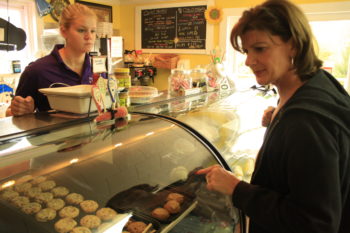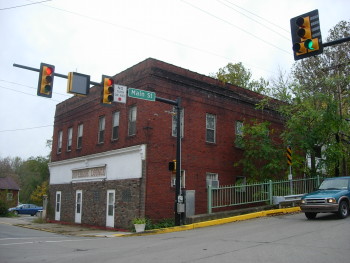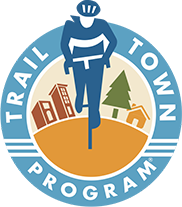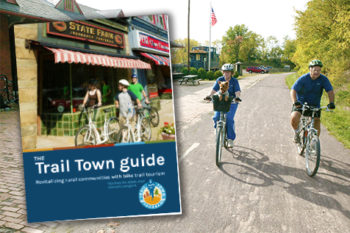Development
To bring trail travelers into town — and keep them exploring and spending — you need a range of basic services. And it can open a world of possibilities for your community.
It takes a lot to develop a Trail Town:
- Build your business district
- Support local business so they thrive
- Develop local real estate
- Find funding
(Looking for more info? Get more detail and hear our success stories in the complete Trail Town guide.)
Building your business district
What a trail town needs
The basic things a trail traveler needs are pretty straightforward: dining, drinks, lodging, things to do and basic services like transportation or medical help.

Local food is the most popular thing people are looking for when they stop into a town. Can your town accommodate riders during breakfast, lunch, dinner and odd hours? Will people with special diets find something they can eat?
Lodging options are vital to keeping your trail growing long-term. Overnight trips drive economic growth: trail users who stay overnight will spend more than 6x the amount per day that a day-ride visitor will. Plus, they stay extra days! An average trip on the GAP is 4-6 days— so that’s 6x the income, multiplied again by 4 to 6.
When you’re growing things to explore in your town, build on what you already have, and try to create a mix of recreation, shopping and historic attractions.
Are you missing any vital businesses?
Look within your local business community to fill the gap first. Can any local merchants take on a new role? Are they interested in expanding?
If no one in your commerce network is taking up the task, recruit entrepreneurs in your community, nearby towns or even outside your area. If your research is showing a need for a service, it will be a more attractive venture to take a chance on.
If you’re in PA, MD or WV, our parent nonprofit, The Progress Fund, might be able to help fund your Trail Town development. Connect with us to learn more.
Business support
When a new business is starting up, connect them to your local Small Business Development Center, who can help them navigate the technical side, and create a solid plan.
Bring businesses together with a unified vision. We used a Trail Town Certified Network to create a common set of standards along the trails in our region. It creates a sense of pride, and we give our members window stickers, which signal bike-friendliness to their potential trail customers.
A common vision will strengthen your trail’s brand and create a cohesive experience, but it’s also helpful to bring your trail businesses together physically, so they can exchange stories and ideas that will help the whole trail thrive. Have networking events. Bring in speakers for a fresh perspective, and spark discussion about important topics like customer service, marketing and sustainability.
Business tools:
- Trail Town business tips
- How to “green” your business: Trail riders say they’re more likely to pay more and travel further to support green, sustainable businesses.
- If you’re in PA, MD or WV, our parent nonprofit, The Progress Fund, might be able to help fund your local businesses. Connect with us to learn more.
Real estate development

You may overlook unattractive spaces and run-down structures in your town, but they turn cyclists away. Turn those eyesores into assets.
If you can’t fix it with a neighborhood clean-up or organic business development, try to take ownership of the property. Now, that’s a huge undertaking, and there’s risk involved. So consider the property carefully.
If it’s worth pursuing, you are probably going to need appraisers, lawyers and mortgage brokers. See what talents your volunteer corps and their networks can offer. If you have to, hire professionals to help. (And ask about community or nonprofit discounts.)
Find funding
For more details about how to fund your program, download our free Trail Town guide.
Get the guide
If your trail is in PA, WV or MD, we might be able to help you get funding by connecting you to our own local partners. Contact us!


